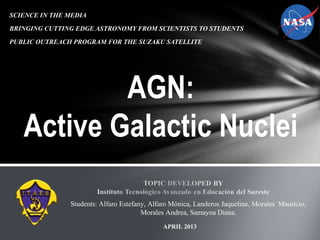
Agn presentation
- 1. SCIENCE IN THE MEDIA BRINGING CUTTING EDGE ASTRONOMY FROM SCIENTISTS TO STUDENTS PUBLIC OUTREACH PROGRAM FOR THE SUZAKU SATELLITE Students: Alfaro Estefany, Alfaro Mónica, Landeros Jaqueline, Morales Mauricio, Morales Andrea, Samayoa Diana. AGN: Active Galactic Nuclei APRIL 2013
- 2. CONTENT 1. What are active galactic nuclei (AGN)? 2. What is an accretion disk? 3. How do astronomers study accretion disks in AGN? 4. What does the «doughnut shaped ring» refer to? 5. Sketch of an AGN with accretion disk, black hole, torus and jets. 6. Types of AGN 7. What is a shrouded AGN or quasar? Why can´t we observe the shrouded AGN in the infrared? Questions assigned under NASA´s Education and Public Outreach Program for the Suzaku Satellite. Materials for Session 1.
- 3. 1. What are Active Galactic Nuclei (AGN)? http://heasarc.gsfc.nasa.gov/docs/objects/agn/agntext.html An artist's conception of an AGN http://imagine.gsfc.nasa.gov/docs/science/know_l2/active_galaxies.html Are galaxies whose nucleus (or central core) produces more radiation than the entire rest of the galaxy. Can have a supermassive black hole (millions of times the mass of the Sun) at the center or be as small as our solar system!
- 4. Definition: It's the ring of gas and dust which may include material drawn from nearby stars or even captured galaxies. http://herschel.jpl.nasa.gov/galaxies.shtml 2. What is an accretion disk? http://www.astro.virginia.edu The yellowish ring of this animated AGN represents the accretion disk http://www.gemini.edu/gallery/v/Posters-and- Prints/album10/GemMSF_FNL_jan22-2.jpg.html If we make a perpendicular cut in an AGN we will find the accretion disk extending from a thick red ring to a bright blue flattening one
- 5. Accretion disks arise when material (usually gas) is being transferred from one celestial object to another. An artist's concept of the accretion disk around the binary star system WZ Sge. http://www.noao.edu/outreach/press/pr08/pr0802.html «Accretion» means collecting of additional material. http://imagine.gsfc.nasa.gov/docs/ask_astro/answers/001106a.html
- 6. Accretion disks in AGN are hard to imagine because they are very small and far away. http://www.mssl.ucl.ac.uk/www_astro/research.html
- 7. 3. How do Astronomers study accretion disks in AGN? An accretion disk forms, emitting huge amounts of light across the electromagnetic spectrum (infrared to gamma rays). The black hole plus the accretion disk produce the phenomena that make AGN visible. http://imagine.gsfc.nasa.gov/docs/science/know_l2/active_galaxies.html It is supermassive black holes what makes AGN so powerful! As the material spirals into the black hole, it heats up to enormous temperatures and emits radiation. http://herschel.jpl.nasa.gov/galaxies.shtml http://spiff.rit.edu/classes/phys240/lectures/blackholes/blackholes.html
- 8. 4. What does the “doughnut shaped ring” refer to? The 2 enormous powerful jets of the AGN are fueled by the emition and reflection of energy at the torus, a donut-shaped gas cloud that absorbs and reflects energy from the accretion disk. JET JET ACCRETION DISK TORUS http://phys.org/news/2012-03-torus-galactic-nucleus.html
- 9. Jets Jets Accretion disks arise when material (usually gas) is being transferred from one celestial object to another. "accretion" means collecting of additional material. Not even light can escape their gravity, and since nothing can travel faster than light, nothing can escape from inside a black hole. http://heasarc.gsfc.nasa.gov/docs/objects/agn/agntext.html 5. Sketch of an AGN: Let´s review
- 10. The strong rotating magnetic field of a black hole creates the jets of accelerated matter that is emitted from the polar regions. Jets Jets This torus is not as dense, but it is much warmer (up to thousands of degrees) and loaded with many more calories. http://heasarc.gsfc.nasa.gov/docs/objects/agn/agntext.html
- 11. 6. Types of AGN They are the most luminous, powerful, and energetic objects known of at this time. They seem to inhabit the centers of active young galaxies and can emit up to a thousand times the energy output of our entire galaxy. According to Hubble’s law the redshift shows that quasars are very distant and, because of their distance, much older than our universe. http://www.universetoday.com/73222/what-is-a-quasar/#ixzz2RxKCwgNw A) QUASARS
- 12. They are point-likes in the sky. Their visible light is often partially polarized. Their output in all wavelength bands varies more rapidly and by a larger amount than a quasar. B) BLAZARS http://imagine.gsfc.nasa.gov/docs/ask_astro/answers/980116b.html Blazars and quasars are intrinsically the same object — a supermassive black hole with a surrounding accretion disk, producing a jet — but seen at different orientation angles with respect to the jet’s axis. http://www.astronomy.com/en/News-Observing/Ask %20Astro/2011/01/Blazar%20vs,-d-,%20quasar.aspx
- 14. Seyfert galaxy nuclei are active galaxies that have strong emission lines. About 2% of spiral galaxies are Seyferts. In its nucleus exists very hot gas which is swirling around very rapidly. Are a type of active galaxy; they are spiral galaxies with extremely bright nuclei. [Image source: Copyright © Anglo-Australian Observatory] http://www.astronomy.ohio-state.edu/~ryden/ast162_9/notes37.html The luminosity f the nucleus of a Seyfert galaxy can vary wildly on time scales of less than a month. C) SEYFERTS
- 16. They are quasars, positioned in such a way that their dusty rings hide their light, while others are buried in dust-drenched galaxies. Spitzer appears to have found both types of missing quasars by looking in infrared light. Unlike X-rays and visible light, infrared light can travel through gas and dust. http://www.nasa.gov/vision/universe/starsgalaxies/spitzer-080305.html 7. What is a “shrouded” AGN?
- 17. Who are we? We find that we live on an insignificant planet of a humdrum star lost in a galaxy tucked away in some forgotten corner of a universe in which there are far more galaxies than people. Carl Sagan SCIENCE IN THE MEDIA BRINGING CUTTING EDGE ASTRONOMY FROM SCIENTISTS TO STUDENTS PUBLIC OUTREACH PROGRAM FOR THE SUZAKU SATELLITE